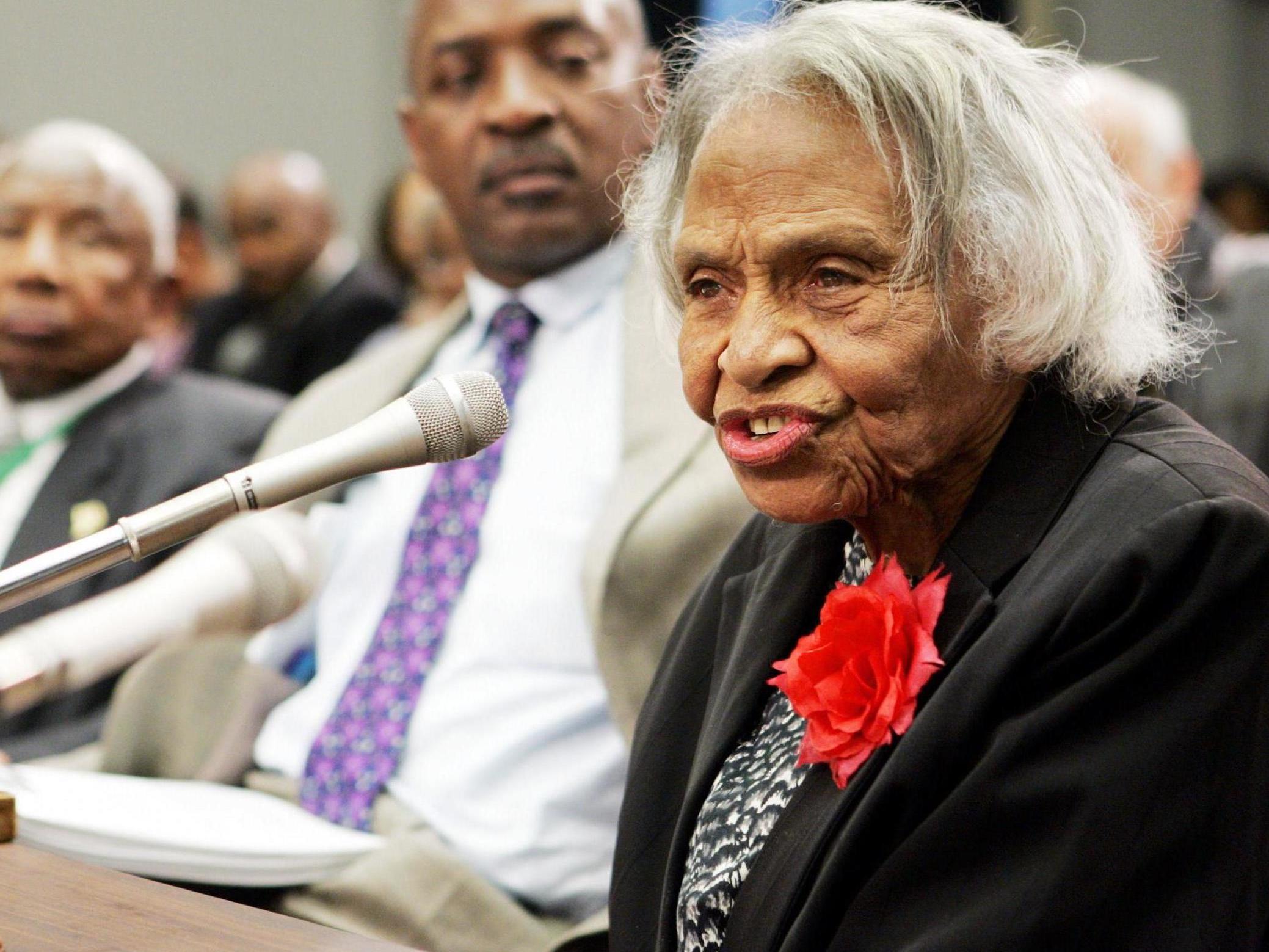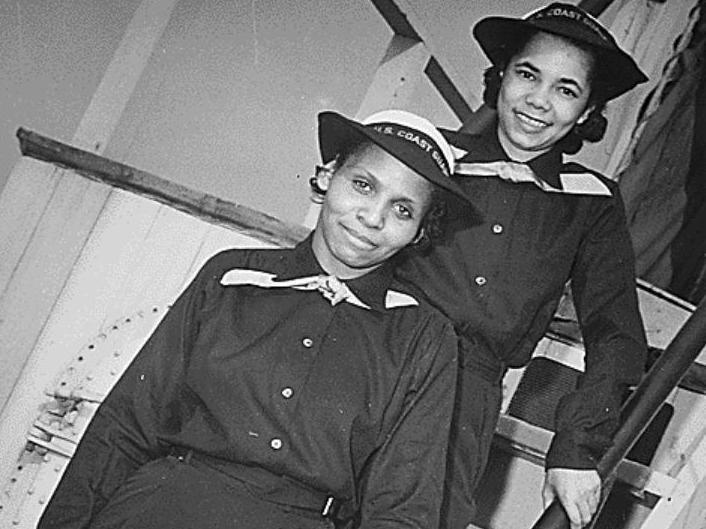Olivia Hooker: Tulsa race massacre survivor and part of US coast guard’s first intake of black women
She was six years old when hundreds of black people died and thousands more lost their homes in one of America’s worst episodes of racist violence

Your support helps us to tell the story
From reproductive rights to climate change to Big Tech, The Independent is on the ground when the story is developing. Whether it's investigating the financials of Elon Musk's pro-Trump PAC or producing our latest documentary, 'The A Word', which shines a light on the American women fighting for reproductive rights, we know how important it is to parse out the facts from the messaging.
At such a critical moment in US history, we need reporters on the ground. Your donation allows us to keep sending journalists to speak to both sides of the story.
The Independent is trusted by Americans across the entire political spectrum. And unlike many other quality news outlets, we choose not to lock Americans out of our reporting and analysis with paywalls. We believe quality journalism should be available to everyone, paid for by those who can afford it.
Your support makes all the difference.She called it The Catastrophe – the notorious 48 hours of fire and death that levelled the neighbourhood dubbed Black Wall Street in Tulsa, Oklahoma. Olivia Hooker was six years old at the time of the Tulsa race massacre, which erupted on 31 May 1921 when a white lynch mob descended on the courthouse where a black teenager was being held.
A group of black war veterans tried to protect the teen, and in the ensuing violence, as many as 300 black people died and thousands more saw their homes and livelihoods torched and levelled. Some people were burnt alive, and 40 square blocks of business and residential property – valued then at more than a million dollars – were destroyed.
Years later, Hooker was among the first black women to serve in the US coast guard. Throwing herself into her studies, she became associate professor of psychology at Fordham University in New York.
Towards the end of her life, however, Hooker, who died aged 103, was best known as one of the last survivors of possibly the deadliest episode of racial violence in American history – oddly, Tulsa was long an afterthought in history texts, if mentioned at all.
Hooker spoke freely about the things she had seen, through the eyes of a frightened girl. Her father, Samuel, owned a department store in Greenwood, the commercial street derided as “Little Africa” but better known as Black Wall Street.
When the mob marched on Greenwood, burning houses and shooting people in the street, Olivia’s mother, Anita, hid her and her siblings under a big oak dining room table as their home was being ransacked.
“We could see what they were doing,” Hooker told The Washington Post in June. “They took everything they thought was valuable. They smashed everything they couldn’t take. My mother had [opera singer Enrico] Caruso records she loved. They smashed the Caruso records.”
They also poured oil over her grandmother’s bed but didn’t light it because members of the white mob were still in the house.

“It took me a long time to get over my nightmares,” she told The Post. “I was keeping my family awake screaming.”
As a little girl, her most searing memory of the massacre was what the mob did to her doll. “My grandmother had made some beautiful clothes for my doll. It was the first ethnic doll we had ever seen ... She washed them and put them on the line. When the marauders came, the first thing they did was set fire to my doll’s clothes. I thought that was dreadful.”
Her family survived the massacre. Her father temporarily relocated the family – including her mother and their five children – to Topeka, Kansas, while he remained in Oklahoma attempting to rebuild his business. He later went on a speaking tour of black Methodist churches to bear witness to the murderous infernos of Tulsa.
A few years later, Hooker returned to the city to attend Booker T Washington High School. “The teachers were scholars, and they were determined every child would do his best, every child would be taught the King’s English,” she said.
During the Second World War, she was part of Delta Sigma Theta sorority’s efforts to forge links with the the US navy, which had started to recruit women. She applied.
“They wrote back and said there is a complication. They wouldn’t tell me what the complication was.”
Instead, she enlisted in the US coast guard in early 1945, three years after congress passed a law approving the creation of the coast guard women’s reserve to help fill jobs vacated by men who went abroad to fight in the war. Hooker became one of the first African American women to join the women’s reserve, known as Spars.
She was stationed in Boston and performed administrative duties before the Spars programme was disbanded in 1946. She was discharged as a petty officer 2nd class, according to a coast guard report, and then went on to complete her doctorate. She became a senior clinical lecturer at Fordham in 1963 and retired from the university in 1985.

Thirty years later, the coast guard named a building on Staten Island after her, breaking the tradition of such christenings in honour of those who’ve died. The service said it was making an exception because of her “distinguished service to the coast guard and her wonderful efforts in serving and helping others”.
Olivia Juliet Hooker was born in Muskogee, Oklahoma, in 1915, and was one of five children. She graduated from Ohio State University in 1937, then worked as a teacher in Columbus, Ohio. In 1947, she received a master’s degree in psychology from the Teachers College, Columbia University. In 1961, she earned a doctorate from the University of Rochester.
She died at her home in White Plains, New York. She had no immediate survivors.
As late as 1997, Hooker worked on the Tulsa Race Riot Commission, which investigated the massacre and issued a report in 2001 “detailing for the first time the extent of the city and state government’s involvement in the riot and in the coverup that followed and the total lack of remedy available in the courts at the time”, according to a congressional report.
Tulsa was racially segregated and reeling from the lynching of Dick Rowland, a 19-year-old shoe shiner. He had walked to the Drexel building, which had the only toilet downtown available to black people. Rowland stepped into a lift. Sarah Page, a white elevator operator, began to shriek.
“While it is still uncertain as to precisely what happened in the Drexel building on 30 May 1921, the most common explanation is that Rowland stepped on Page’s foot as he entered the elevator, causing her to scream,” the Oklahoma Historical Society reported.
The Tulsa Tribune published a news story with the headline “Nab Negro for Attacking Girl in Elevator”, which many historians say prompted the massacre. Tulsa’s mayor recently reopened an investigation into mass graves, where witnesses say victims of the massacre were buried.
In 2003, more than 100 survivors and about 300 descendants of those who lost property or were killed in the massacre filed a civil rights lawsuit against the city of Tulsa and the state of Oklahoma, seeking compensation for the damages that occurred as a direct result of the government’s involvement in the massacre. In 2005, the US Supreme Court dismissed the lawsuit without comment.
Survivors were crestfallen.
“I was glad so many of us were still there, still in the world trying to do good,” Hooker told The Post in June. “There are a lot of answers I was never able to figure out.”
In 2015, as she sat in the front row at a coast guard ceremony, she watched as President Barack Obama honoured her, recounting her life story. He described her as a “tireless voice for justice and equality”.
Olivia Hooker, psychology professor, born 12 February 1915, died 21 November 2018
© Washington Post
Join our commenting forum
Join thought-provoking conversations, follow other Independent readers and see their replies
Comments